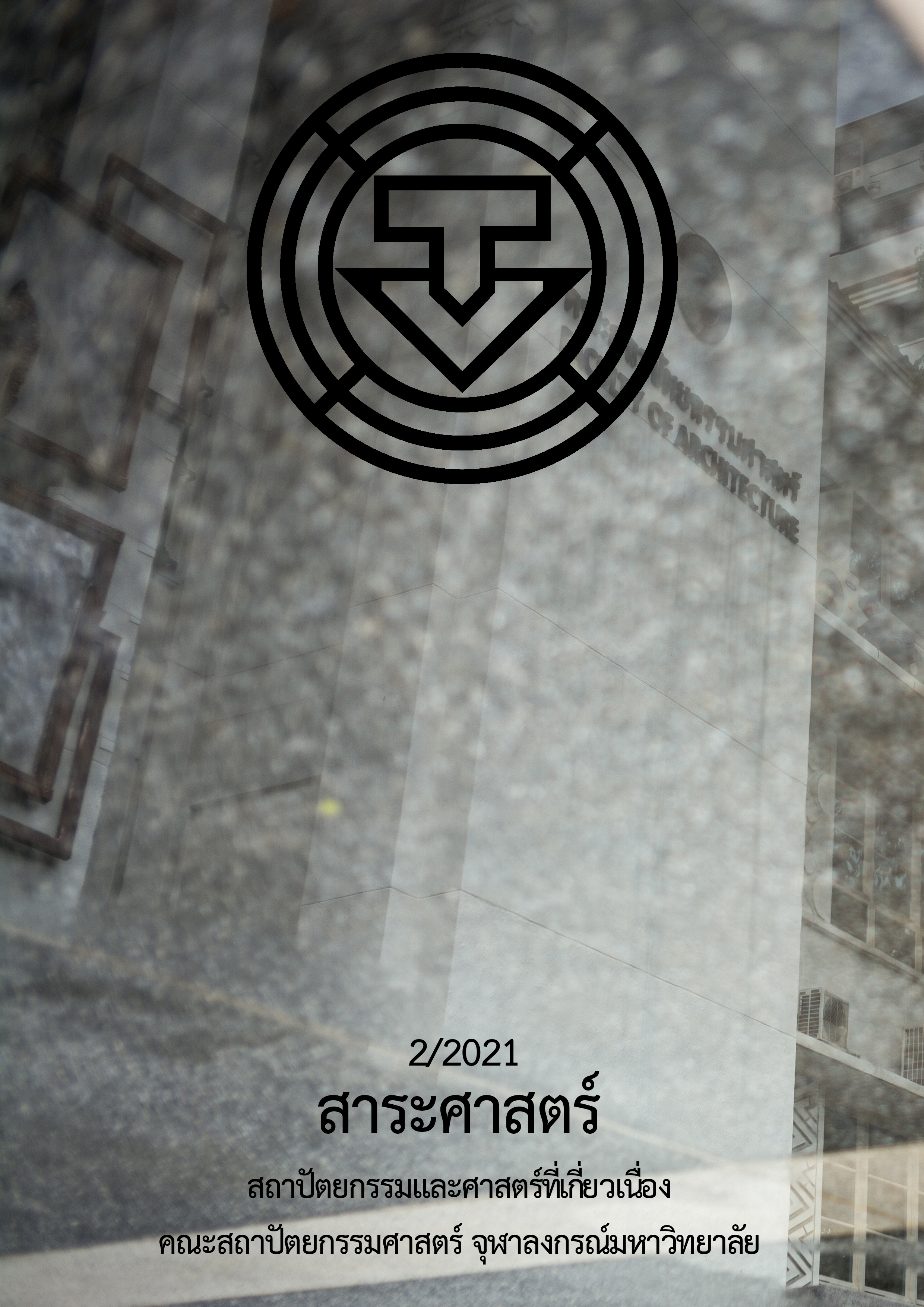The Evaluation of Energy Efficiency of Base Case Residential Building
Main Article Content
Abstract
The global warming crisis is a major problem facing the global society at present time. According to a survey by the Ministry of Energy, households or residences account for 23% of electricity demand, which is the second number of total electricity demand in Thailand. This research focuses on the architectural elements of residential buildings, which are the factors affecting the use of electrical energy in residential buildings. To analyze and find ways to conserve energy efficiently. This research takes the base case residential building which is the most common type of residential buildings in Thailand from the research project to study the criteria of energy consumption in residential building and create energy-saving home prototypes by the Department of Alternative Energy and Energy Efficiency (DEDE), Ministry of Energy, Which has been surveyed and collected data on the characteristics and shape of most basic houses in Thailand. It also can be used as a model representative to assess the efficiency of energy conservation of residential buildings in Thailand.
Methods for Studying The Evaluation of Energy Efficiency of Base Case Residential Building in Thailand have suggested 2 basic guidelines for the improvement of residential building, which are Guideline 1 modification of building materials and Guideline 2 design modification focusing on shading of the eaves and roof. This research relies on modeling and analyzing results through the program DOE2.1E ver.121.
The results of the study showed that the building improvements according to the Guideline 1 modification of building materials can save more electricity. The electricity consumption is 4,240 kWh / yr and the cost of renovation is 59,812 baht, while renovating the building, according to the Guideline 2 design modification, can save less energy than the Guideline 1. The electricity consumption is 4,873 kWh / yr and the cost of renovation is 28,342 baht. According to analyzing the cost of investment, it was found that the Guideline 2 design modification is more suitable for economics. Since it has a faster payback period which is 8 years and 9 months. However, the improvement of the building, according to the two recommendations , still shows significant efficiency in energy conservation. If the pattern and the appearance of the building is appropriate, there will be no need for renovations later. It can be concluded that architectural design is the first important factor that must be taken into consideration before selecting materials.
Article Details
References
กรมพัฒนาพลังงานทดแทนและอนุรักษ์พลังงาน. (2549). แบบประเมินอาคารประหยัดพลังงานและเป็นมิตรต่อสิ่งแวดล้อมสำหรับอาคารพักอาศัย: บ้านเดี่ยว บ้านแถว อาคารอยู่อาศัยรวม รุ่น R 49.00. กรุงเทพฯ: กรมพัฒนาพลังงานทดแทนและอนุรักษ์พลังงาน.
กรมพัฒนาพลังงานทดแทนและอนุรักษ์พลังงาน. (2559). โครงการศึกษาเกณฑ์การใช้พลังงานในบ้านพักอาศัย และสร้างต้นแบบบ้านประหยัดพลังงาน. กรุงเทพฯ: สถาบันเทคโนโลยีพระจอมเกล้าเจ้าคุณทหารลาดกระบัง.
กรมพัฒนาพลังงานทดแทนและอนุรักษ์พลังงาน. (2561). โครงการศึกษาเพื่อจัดทำเกณฑ์มาตรฐานประสิทธิภาพพลังงานของบ้านที่อยู่อาศัย. กรุงเทพฯ: สถาบันเทคโนโลยีพระจอมเกล้าเจ้าคุณทหารลาดกระบัง.
กระทรวงพลังงาน. สำนักงานนโยบายและแผนพลังงาน (สนพ.). (2558). แผนอนุรักษ์พลังงาน พ.ศ.2558–2579 (Energy Efficiency Plan; EEP 2015). กรุงเทพฯ: สำนักงานนโยบายและแผนพลังงาน (สนพ.) กระทรวงพลังงาน.
กุลวิชญ์ นุ้ยเพชร. (2558). ความคุ้มค่าในการลงทุนปรับปรุงอาคารพาณิชย์เก่าเขตพื้นที่ย่านธุรกิจ (CBD) ให้เป็นโฮมออฟฟิศเชิงอนุรักษ์พลังงาน. (วิทยานิพนธ์ปริญญามหาบัณฑิต, มหาวิทยาลัยธรรมศาสตร์).
ฉกาจ เชื่อดี. (2552). การจัดการประสิทธิภาพด้านความร้อนของเปลือกอาคารของอาคารในภาคตะวันออกเฉียงเหนือ.(วิทยานิพนธ์ปริญญามหาบัณฑิต, มหาวิทยาลัยเทคโนโลยีราชมงคลอีสาน).
ปวเรศ ถาวรประเสริฐ. (2558). การศึกษาความเป็นไปได้การลงทุนอาคารเขียวตามเกณฑ์ประเมินคสามยั่งยืนทางพลังงานและสิ่งแวดล้อมไทย. (วิทยานิพนธ์ปริญญามหาบัณฑิต, มหาวิทยาลัยธรรมศาสตร์).
ปัทมาภรณ์ รัตนประดับ. (2554). แนวทางการปรับปรุงบ้านเดี่ยวสองชั้น โครงการบ้านเอื้ออาทร จังหวัดขอนแก่น เพื่อการประหยัดพลังงานและเผ้นมิตรต่อสิ่งแวดล้อม. (วิทยานิพนธ์ปริญญามหาบัณฑิต, มหาวิทยาลัยขอนแก่น).
วงศิยา อนุศุกดากุล. (2559). แนวทางการปรับปรุงอาคารสำนักงานภาครัฐในประเทศไทยให้เป็นอาคารที่ใช้พลังงานสุทธิเป็นศูนย์. (วิทยานิพนธ์ปริญญามหาบัณฑิต, มหาวิทยาลัยศิลปากร).
โสพิศ ชัยชนะ. (2558). แนวทางการปรับปรุงอาคารสำนักงานสาธารณสุขจังหวัดเพื่อประหยัดพลังงาน. (วิทยานิพนธ์ปริญญา มหาบัณฑิต, มหาวิทยาลัยศิลปากร).
อภิชญา อธิคมบัณฑิตกุล. (2555). การศึกษาเปรียบเทียบประสิทธิภาพวัสดุหลังคาที่มีสัมประสิทธิ์การแผ่รังสีต่ำและฉนวนกันความร้อนทั่วไป. (วิทยานิพนธ์ปริญญามหาบัณฑิต, จุฬาลงกรณ์มหาวิทยาลัย).
กระทรวงพลังงาน. [ม.ป.ป.]. คู่มือการออกแบบอาคารที่มีประสิทธิภาพด้านการประหยัดพลังงาน. สืบค้นเมื่อ 31 มกราคม 2564, จาก http://www.dede.go.th/ewt_news.php?nid=78&filename=index
กระทรวงพลังงาน. [ม.ป.ป.]. แนวทางเบื้องต้นในการออกแบบการอนุรักษ์ประสิทธิภาพสูงเชิงสถาปัตยกรรม. สืบค้นเมื่อ 31 มกราคม 2564, จาก http://www.enconfund.go.th/pdf/Architectural-Guidebook.pdf
The U.S. Department of Energy. (1980). DOE-2 reference manual part1 version2.1. Retrieved from https://doe2.com/Download/DOE-21E/DOE-2ReferenceManualVersion2.1A.pdf


